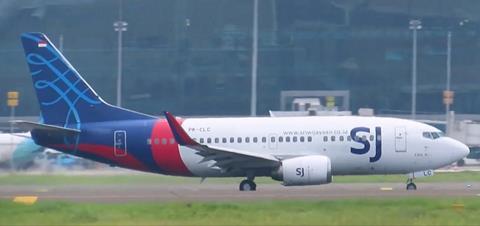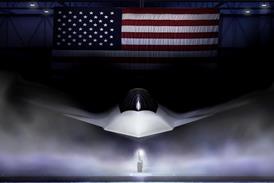Indonesian investigators have determined that the right-hand throttle lever on a Sriwijaya Air Boeing 737-500 did not move backwards when the autothrottle commanded reduced power, resulting in thrust asymmetry and a fatal in-flight upset.
None of the 62 occupants of the aircraft, operating from Jakarta to Pontianak on 9 January last year, survived after the thrust imbalance caused the 737 to enter an uncommanded left roll and rapidly descend.
The aircraft’s autothrottle computer was equipped with a cruise thrust split monitor, which uses spoiler positions to check for asymmetric thrust, and is designed to disengage the autothrottle to prevent an upset.
But the inquiry into the accident, on 9 January last year, believes that an erroneous spoiler signal value prevented this function activating.
Some 2min after take-off, as the aircraft neared 8,000ft, a change in autopilot directional control led the autothrottle to command a reduction in thrust.
But while the left-hand throttle lever began to move backwards, causing the left engine’s thrust to decrease, the right-hand lever did not move with it, instead remaining in position and leaving the right engine thrust unchanged.
Investigators state that the autothrottle system experienced a mechanical “friction or binding” which obstructed movement on the right-hand throttle lever.
Since this throttle lever was not moving backwards, the left-hand lever retarded further in order to compensate and achieve the required thrust reduction.
“The thrust levers diverged and a thrust asymmetry occurred,” says the inquiry. “The asymmetry became greater over time and eventually resulted in uncommanded roll to left.”

At the time of the upset the crew had been trying to conduct a right turn for weather avoidance. The inquiry says the aircraft initially banked to the right but, as it climbed past 10,450ft, it rolled wings-level and then continued rolling to the left.
The roll reached 37° left, triggering a ‘bank angle’ warning at about 10,700ft, the highest altitude achieved by the jet.
Flight-data analysis shows the left engine’s speed reduced to 34% of N1 but that of the right engine remained at 91.8%.
The roll increased to more than 45° and was “further exacerbated” by left-roll pilot commands, the inquiry says, and the aircraft pitched nose-down, entering a descent from which the crew failed to recover.
According to the inquiry, the aircraft maintenance log had recorded 65 pilot reports relating to the autothrottle as well as 61 reports relating to differences in the engine parameters, particularly during descent.
Quick-access recorder analysis showed that seven flights by the aircraft (PK-CLC) in the year perior to the accident experienced abnormal throttle-lever movement.
These included a service on 15 March 2020 which had been commanded by the same captain as the ill-fated flight.
During this service the aircraft had been passing 4,400ft when both throttle levers moved backwards, before the right-hand lever stopped while the left-hand lever continued. Asymmetric thrust developed and the aircraft rolled into a 41° left bank. The crew of the flight noticed the asymmetric condition and restored the throttle levers to matching positions.
There was “no pilot report” of any of the seven occurrences in the aircraft maintenance log, says the inquiry: “Most of the pilots stated that they did not recall the occurrences.”
Investigators state that the aircraft was grounded for several months – from March to December 2020 – while a number of maintenance tasks were conducted. But after the jet was released to service, three weeks before the crash, the log recorded 43 pilot reports including three involving autothrottle issues.
“Corrective maintenance processes of the [autothrottle] problem were unable to identify the friction or binding within the mechanical system of the thrust lever, and resulted in the prolonged [lack of resolution] of the [problem],” the inquiry adds.


























